D2C vs B2C in eCommerce: Difference, Pros, Cons & Examples
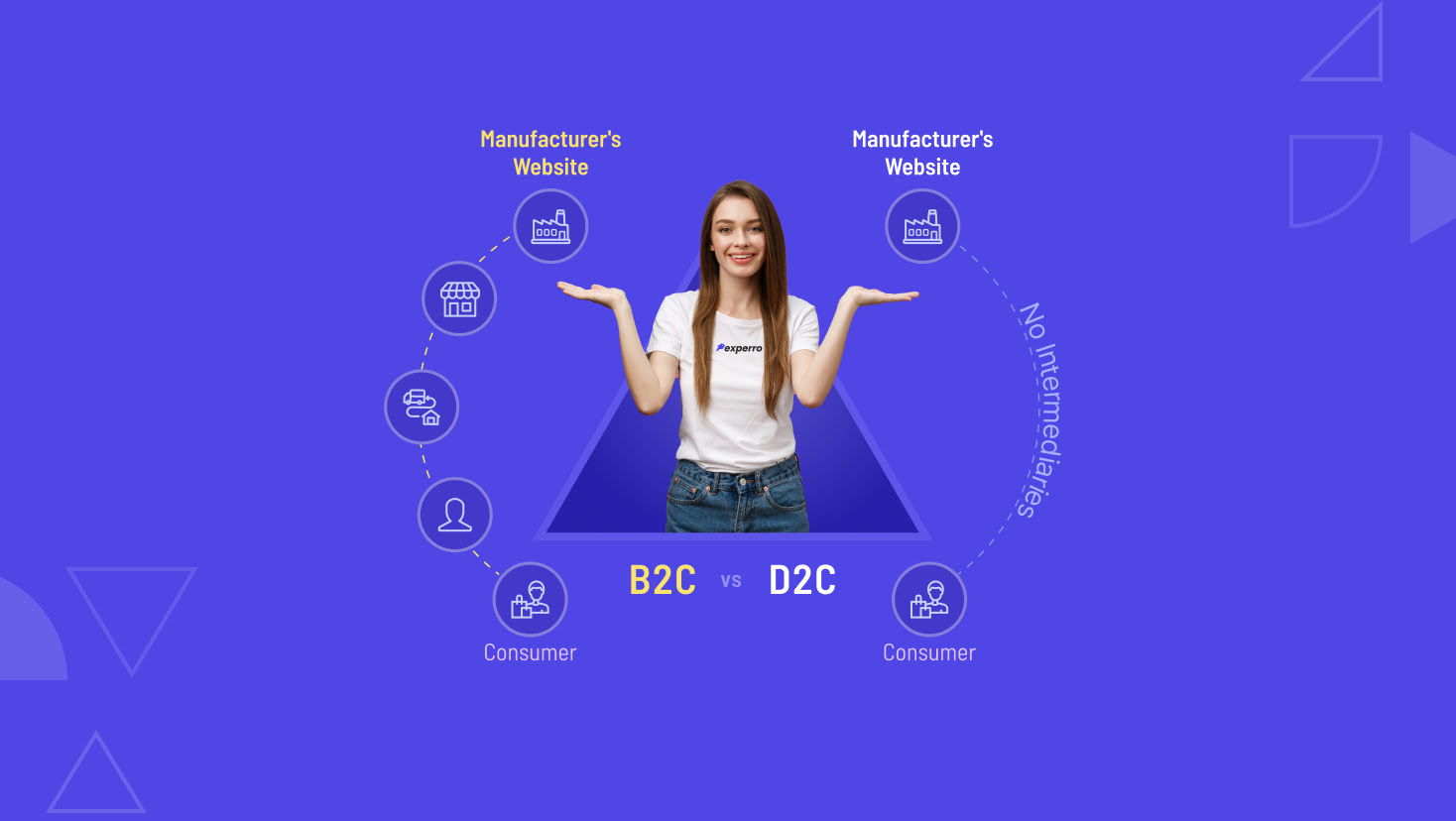
What’s Inside
- What Is the Difference Between D2C and B2C Business Models?
- What Is B2C eCommerce?
- What Are the Game-Changing B2C Advantages?
- What Are the Limitations of Business to Consumer eCommerce Business Model?
- What Is D2C eCommerce?
- What Are the Transformative D2C Benefits?
- What Are the Limitations of D2C eCommerce Business Model?
- How Experro Helps B2C and D2C eCommerce Brands?
- Conclusion
Key Takeaways
- B2C vs. D2C is a reflection of how businesses navigate the retail models to align with evolving customer preferences.
- The difference between B2C and D2C lies in the approach of reaching the end customer.
- In B2C eCommerce, products are often sold through intermediaries, while D2C eCommerce eliminates these middlemen.
- Experro can elevate the online presence of B2C and D2C businesses by providing personalized digital experiences to customers.
Both D2C vs B2C business models aim to effectively deliver goods or services to end consumers. However, they involve different approaches to reach the end customer.
Knowing the difference is crucial as it enables businesses to make informed strategic decisions about their market approach, and effectively meet the expectations of their target audience.
So, in this blog, we will explore the actual difference between D2C and B2C. We will also dive into the advantages and limitations of these business models.
What Is the Difference Between D2C and B2C Business Models?
Let’s understand the difference between D2C vs B2C from the table below:
Basis of Difference | D2C | B2C |
|---|---|---|
| Meaning | Businesses sell directly to individual consumers. | Businesses sell customers through mediators. |
| Examples | Warby Parker, Casper, Glossier. | Amazon, Walmart, eBay. |
| Customer relationship | Direct relationships with customers. | Relationships are mediated through platform policies |
| Logistics & Fulfillment | Retailers manage their logistics and fulfillment. | May use platform-provided fulfillment services. |
| Customer Trust | Trust is built directly between the brand and customers | Trust may be influenced by the reputation of the platform. |
| Marketing Autonomy | Full autonomy in digital marketing strategies and campaigns. | Limited autonomy due to platform restrictions. |
For an in-depth comparison of D2C vs B2C, let's understand the meaning of B2C eCommerce.
What Is B2C eCommerce?
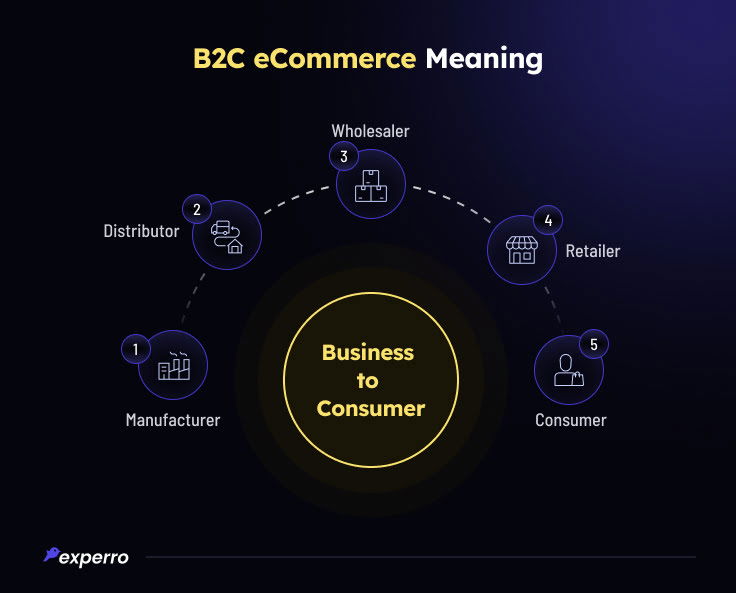
B2C (business to consumer) eCommerce is a business model that involves selling products or services to the end consumer through an intermediate party.
In the B2C Commerce model, businesses can rely on various retailers as intermediate parties.
B2C is a widely popular eCommerce business model. In fact, the global B2C eCommerce market size reached US$ 4.8 trillion in 2023.
Reason?
With the B2C model, customers get access to a wide variety of products from different retailers. This makes it a convenient and appealing option to them. On the other hand, retailers can tap into the existing customer base of the eCommerce website.
B2C Example
Amazon is a popular example of the B2C business model of eCommerce. It sells a wide range of products to end consumers through different retailers.
Here, the intermediators or third parties are different retailers who have registered themselves on the platform.
What Are the Game-Changing B2C Advantages?
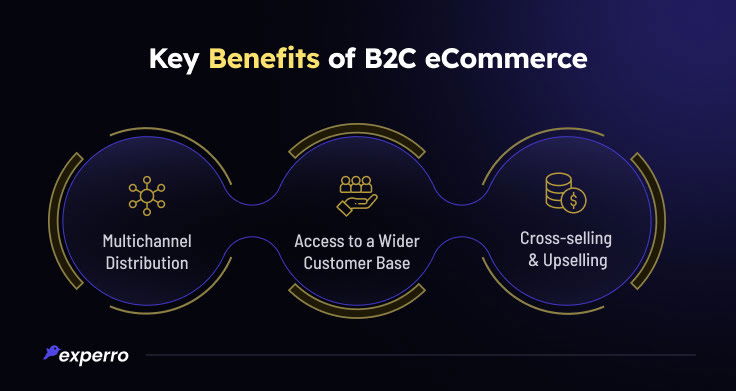
The business-to-consumer businesses have several advantages. Some of the key advantages are as follows:
1. Access to a Wider Customer Base
Access to the wider customer base is one of the most significant advantages of business to consumers. The B2C business models often bring established retailers on their platforms. These retailers act as an intermediary, displaying their products in the marketplace.
- The first reason for having access to a larger customer base is the existing brand image of established retailers.
- The second reason is when customers want a variety of products; they don’t need to jump to different websites. Instead, they can enjoy a wide variety of products on the website itself.
2. Multichannel Distribution
A total of 73% of retail consumers prefer multiple channels while shopping.
B2C companies sell products through multiple channels, such as websites/online stores, social media channels, and even brick-and-mortar stores.
Being accessible on multiple channels increases brand value and customer engagement.
Moreover, customers can choose any channel according to their convenience, which enhances customer experience.
3. Cross-selling and Upselling
Since B2C eCommerce business models often involve large product catalogs from different retailers, marketers can seize the opportunity to cross-sell and up-sell products on the marketplace.
Cross-selling involves suggesting additional products that are related to the purchase of customers. At the same time, upselling refers to suggesting a more upgraded/higher version of the product.
For instance, when buying shoes, the suggestion of a pair of socks is cross-selling, and the suggestion of a premium version of the same shoes is up-selling.
What Are the Limitations of Business to Consumer eCommerce Business Model?
The following points highlight the limitations of B2C eCommerce:
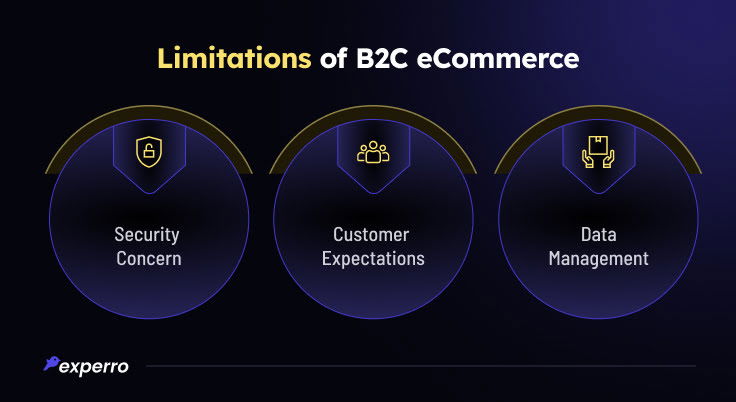
1. Security Concern
B2C eCommerce platforms often involve huge product catalogs and huge customer data on their websites.
It involves the exchange of sensitive customer information, including their personal details and payment information.
Inadequate protection of this data can lead to privacy breaches and security threats.
To avoid these security threats, the B2C eCommerce website may need a unified CMS solution that prevents data breaches.
2. Customer Expectations
Customers expect a seamless, user-friendly online experience from B2C brands due to the higher convenience and accessibility offered by digital platforms.
Additionally, they often benchmark their expectations from leading B2C brands.
TIP – Delivering personalized content is a solution to exceed customer expectations and elevating online presence.
3. Data Management
Data management in B2C eCommerce is challenging due to the vast amount of customer-related information transactions and the need for personalized and real-time communication.
B2C eCommerce platforms consist of large volumes of data, including customer profiles, purchase history, and interaction. Managing this complex data can be overwhelming for business owners.
Now that we know what B2C eCommerce is, let's understand D2C meaning, example, and benefits.
What Is D2C eCommerce?
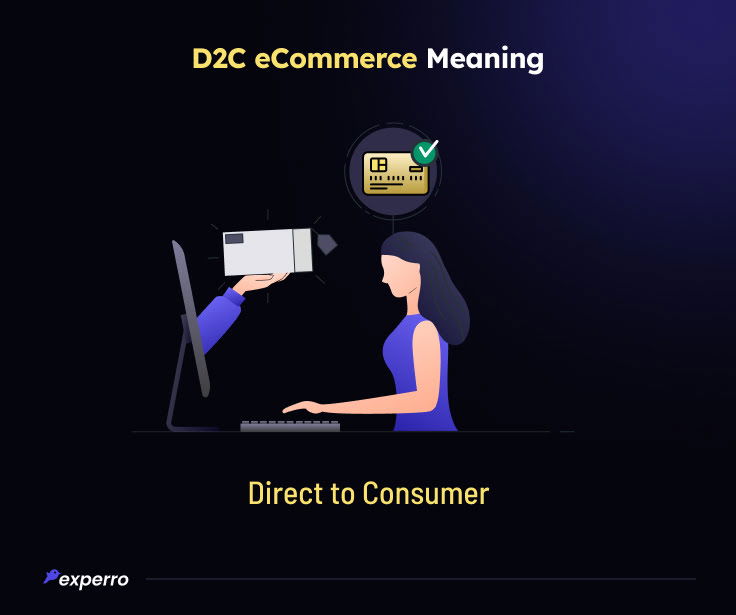
D2C (direct to consumer) business model of eCommerce refers to goods or services to end users bypassing the intermediate party.
Unlike B2C, the brands themselves manage everything from manufacturing, packaging, marketing, and delivering goods to the customers. Hence, this is D2C explained.
D2C Example
Warby Parker is a well-known D2C eCommerce brand. It sells prescription eyeglasses and sunglasses directly to customers through its eCommerce website and physical retail stores, bypassing traditional optical retailers.
What Are the Transformative D2C Benefits?
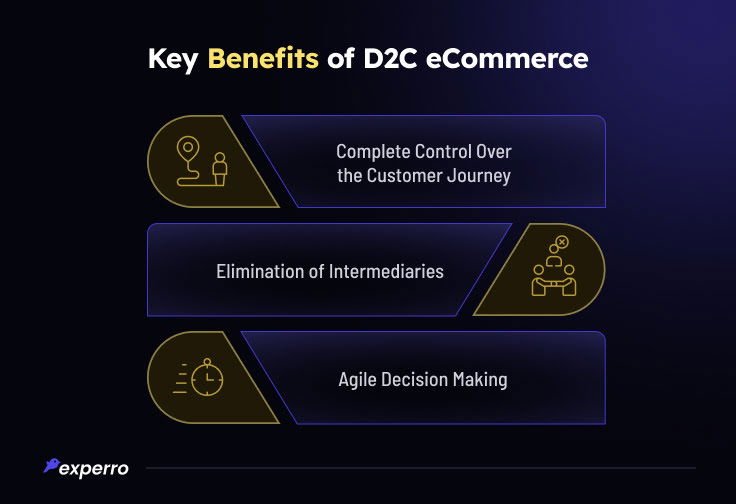
Let’s understand the advantages of D2C eCommerce from the points mentioned below:
1. Complete Control Over the Customer Journey
D2C eCommerce enables full control over the customer journey as manufacturing, marketing, and supply everything is handled by the business owner. There is no involvement of third parties.
Moreover, bypassing intermediaries enables a direct relationship with customers, which enables brands to provide personalized service to customers. This allows one-to-one interactions and timely responses to inquiries.
Furthermore, D2C brands have access to more customer insights from different sales channels since they are the direct sellers.
With these valuable customer insights, marketers can create personalized marketing campaigns that resonate with their target audience and increase brand loyalty.
2. Elimination of Intermediaries
Direct to consumer eCommerce bypasses the intermediate party and sells products directly to the customers. This is how they don’t need to cut short on their profit margins.
Moreover, they have control over pricing structure, marketing strategies, and everything. This flexibility enables businesses to make i
3. Agile-Decision Making
With a direct connection to consumers, D2C businesses can quickly respond to emerging market trends.
The agility allows for the introduction of new product features or marketing campaigns according to the shifts in consumer behavior.
What Are the Limitations of D2C eCommerce Business Model?
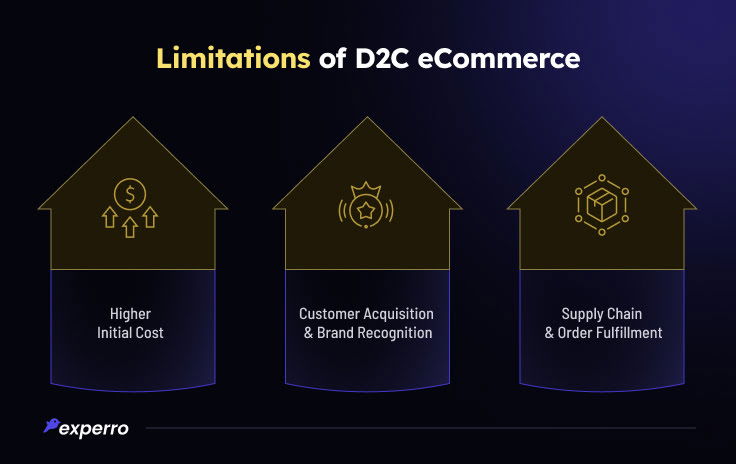
The pitfalls of the D2C model are as follows:
1. Higher Initial Cost
D2C eCommerce businesses often need to manage everything on their own. They need to establish a direct channel to consumer demands with investment in technology marketing infrastructure everything.
Moreover, unlike established B2C brands, D2C brands need to invest heavily in awareness, brand recognition, and attaining customers.
2. Customer Acquisition & Brand Recognition
D2C brands often compete with established online retailers and B2C eCommerce platforms.
Competing with well-known brands and platforms that already have a stronger customer base can make customer acquisition more challenging.
Moreover, establishing trust is critical in D2C eCommerce. Customers may be hesitant to try new products from unknown brands online.
D2C brands may heavily need to rely on promotions, discounts, and marketing campaigns to attract potential customers.
3. Supply Chain & Order Fulfillment
D2C eCommerce platforms typically operate on a smaller scale as compared to other retailers and marketplaces.
Consequently, they have higher production costs that affect profit margins, making it crucial for D2C brands to find cost-effective solutions.
Moreover, direct control over the supply chain means D2C brands must manage inventory levels efficiently.
This requires a unified system and real-time data to track product demand inventory management and reduce excess carrying costs.
Here's a visual description of the differences between D2C vs B2C. Check it out!
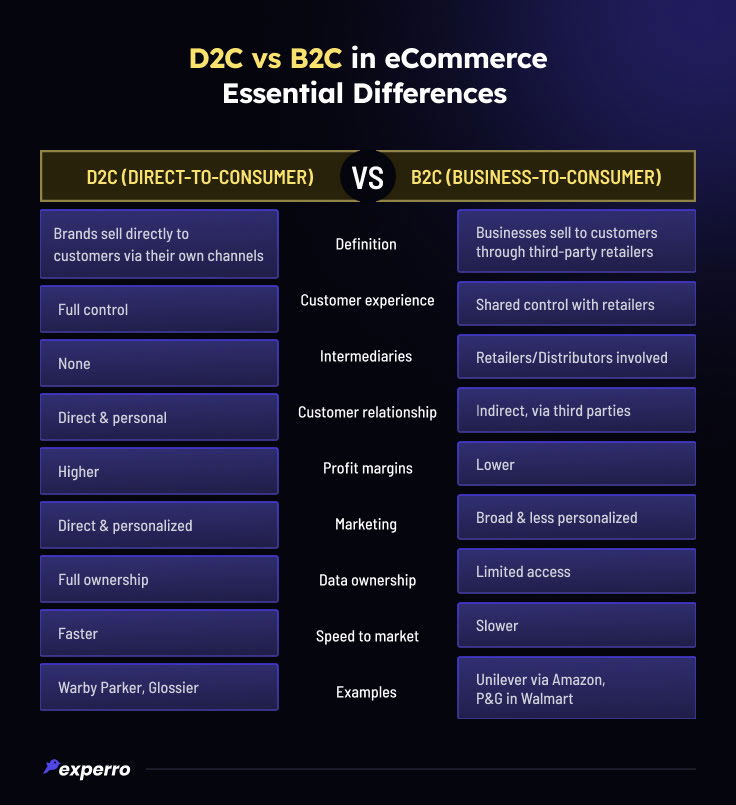
Now that we have explored the b2c vs d2c examples, benefits, limitations; let's look into how Experro DXP can help you.
How Experro Helps B2C and D2C eCommerce Brands?
Whether you run a D2C or B2C eCommerce business Experro DXP (Digital Experience Platform), offers a suite of features that can significantly elevate your online presence. Experro includes the following features to enhance customer experiences.
- Headless CMS
The power-pack headless CMS empowers brands to efficiently manage and organize large volumes of product data and content, ensuring consistent and engaging online experiences. ·
- Personalization Capabilities
It enables tailored online shopping experiences, with product recommendations and customized content. When users come across the products they relate with, it enhances customer experience. Additionally, with eCommerce merchandising tool, brands can strategically place products, boosting discoverability and eCommerce sales.
- AI-Powered Search
Experro's AI-powered search ensures customers find what they're looking for quickly and accurately. The AI based search functionality includes NLP (natural language processing), auto correct and personalization to enhance the search experience.
- Analytics
Through the robust analytics feature, Experro provides data-driven insights into customer behavior and preferences. In the battle of D2C eCommerce vs B2C eCommerce, Experro's innovative features have got your back either ways.
Conclusion
In conclusion, the comparison of B2C vs D2C eCommerce identifies how businesses can navigate the digital market and overcome the limitations of these two business models. B2C uses established retail channels for a broader market rate, while D2C connects directly with customers building loyalty.
Both platforms have their advantages and limitations. However, a cutting-edge DXP can enhance the online presence of B2C or D2C ecommerce brands.
So, it’s all about how you leverage technology to deliver the best digital experiences to customers. Compare the b2c vs d2c benefits and limitations, and start your eCommerce business today.
Schedule a call with the team at Experro to explore how we can transform your business and enhance your online presence.
FAQs


Priya Zala
29 May 2024Through her writing, she has a lovely way of capturing users' pain points and delivering solution-oriented content. Her writing is sure to captivate readers and leave them with a lasting impression. When not crafting content, Priya enjoys getting lost in a good work of fiction, which soothes her soul.